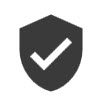|
Application Security is used to create, define and maintain users, roles and groups and their permissions. |
Tab |
Description |
|
A user is someone with a user name and password. A user can be anyone from an administrator or box office ticket seller to online customers. Users can be assigned one or more groups and/or roles that determine how they can use the system. |
|
A group defines the functionality that users have permission to use. For example, a group specifies whether users can create, modify and/or delete an item, what pages they can view, and so on. Groups and roles work together to define a user’s experience. For example, ticket sellers need access to the event (by means of their role) and access to selling functionality (by means of their group). |
|
Roles determine user access, and are most often used to reflect an organization’s sales channels. Access to the following items can be restricted by role: •Venues •Events and Bundles •Service Charges and Miscellaneous Items •Payment and Delivery Methods •Hold Types •Fundraising Programs
When users log in their role determines which items they can access. Their group determine what they can do with the item. Users might have multiple roles, but they can only use one role at a time. Roles can be changed at anytime using the Options menu. |
|
The Audit tab tracks each action or event that occurred while a user was logged in. . |
|
Each time a user logs in or out, the information is tracked and accessible from the Logins|Search page. Once a session has been selected, the Audit|Search page appears and a search is automatically performed using only the 'Session ID'.
|





